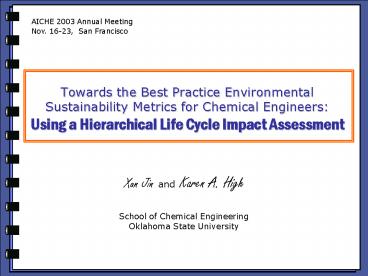Towards the Best Practice Environmental Sustainability Metrics for Chemical Engineers: Using a Hierarchical Life Cycle Impact Assessment - PowerPoint PPT Presentation
1 / 20
Title:
Towards the Best Practice Environmental Sustainability Metrics for Chemical Engineers: Using a Hierarchical Life Cycle Impact Assessment
Description:
AICHE 2003 Annual Meeting Nov. 16-23, San Francisco Towards the Best Practice Environmental Sustainability Metrics for Chemical Engineers: Using a Hierarchical Life ... – PowerPoint PPT presentation
Number of Views:285
Avg rating:3.0/5.0
Title: Towards the Best Practice Environmental Sustainability Metrics for Chemical Engineers: Using a Hierarchical Life Cycle Impact Assessment
1
Towards the Best Practice Environmental
Sustainability Metrics for Chemical Engineers
Using a Hierarchical Life Cycle Impact Assessment
AICHE 2003 Annual Meeting Nov. 16-23, San
Francisco
- Xun Jin and Karen A. High
- School of Chemical Engineering
- Oklahoma State University
2
SusCAD
3
Sustainability Concept
- Definitions
- - Inter/intra-generation equity view
- - Critical limits view
- - Competing objective view
- Basic characteristics
- - Vagueness
- - Complexity
- - Transdiscipinarity
- - Flexibility
4
Difficulties for Chemical Engineers
- Conceptual intricacy
- Perspective diversity
- Knowledge deficiency
- Relevancy emphasis
?
?
?
5
Metric Transformations
- Paradigm shift Greening to Sustaining
- - NAE NRC (1999)
6
Best Practice Metrics
- Is there a set of best practice metrics in
general ?
- Impossible no-size-fits-all - Trade-offs
between desired features, cost and feasibility -
Lack of systematization
- What will help?
- - Identified endpoint(s) and the pertinence to
the endpoint(s) - - A well-defined assessment framework that
allows operational diversity - - A scientifically sound classification
7
Endpoint and Causality
- Causality represents the relevancy to
sustainability - Traditional isolated endpoints ignored the
integration of the environment - Extended endpoint
8
Endpoint Human Welfare ?
- Bad
- - Still Fuzzy
- - Less defendable environmental relevancy
- Good
- - Independent to the subsystems
- - Endpoint reflects maximum relevance, provide
an important criterion to evaluate alternatives - - A universal endpoint, Canary in coal mine or
common currency
9
Assessment Framework
- LCA is the best candidate
- - Well-developed theoretical framework
- - Prosperous resources and applications
LCA derived methods Developer Year
EDIP Wenzel 1997
CML Heijungs 1992
CML Guinee 2002
Eco-indicator Pre 1995
Eco-indicator Pre 1999
TRACI USEPA 2002
- Provides no default metric
- Variety in metric selection
10
Handling Variety
- A multi-level hierarchy could potentially tackle
the inconsistency and classify the metrics - Existing frameworks include
Pressure-State-Response (PSR) OECD
Driving force-State-Response (DSR) UNCSD
Pressure-State-Impact-Response (PSIR) UNEP
Driving force-Pressure-State-Impact-Response (DPSIR) EU
11
A SSEIW Hierarchy
- Stressor
- The discharges associating with a given human
activity - Status
- The induced state change of the exact
environmental compartment that the stressors are
directly exerted on - Effect
- The resulting environmental impacts that embody
certain aspect of societal concern - Integrality
- Component completeness, structural rationality
and functionality of the environment as a whole - Well-being
- The damages caused by all the prior aspects to
human welfare
Impact
CFCs emission
Stressor
12
LCA Framework
I Define impact category II
Identify category indicator III Select
characterization model VI Classification
V Characterization VI
Normalization VII Grouping VIII
Weighting
13
Operational Issues
- Bottom-up vs. Top-down
- - Bottom-up
- The target problem is analyzed first without a
concrete goal. This approach may not be adequate
for the achievement of specific goals, mostly
adopted by scientists, engineers and other people
who is interested in the performance of the
particular system - - Top-down
- The top-down scheme starts with defining the
assessment goals and aims to evaluate the
accomplishment of specific goals. The limitation
of this approach is that pre-defined goals
sometime have to be compromised with indicator
availability. Mostly applied by managers,
environmentalists, policy-makers
Top-down
Bottom-up
CFCs emission
Stressor
14
Operational Issues (cont.)
- Two-dimensional Impact Categorization
Across the causal chains
Status
Effect
Along the causal chains
Integrality
15
Operational Issues (cont.)
- Indicator and characterization model selection
- - Compatibility of the indicators across
multiple levels depends on how to utilize them in
decision-making - - Develop a characterization model
Status Selected property environmental model
Effect Selected property environmental model fate, exposure and effect analysis
Integrality Eco-modeling systems analysis
16
Example
- Ground level ozone formation
17
Example (cont.)
- Different metrics of measuring environmental
sustainability
18
Conclusion
- Keep an open mind
- Best practice is
- - Goal satisfaction at allowable cost with
available resources - - Apply Life Cycle Assessment theoretical
framework - - Maximize sustainability relevancy in a valid
manner - - Customize metrics according to the proposed
hierarchy - - Effective decision-making paradigm
- The future research
- - Case study
- - Human welfare indicator
- - decision-making using pareto optimality
concept
19
Acknowledgement
- Environmental Institute _at_ OSU
20
Questions































